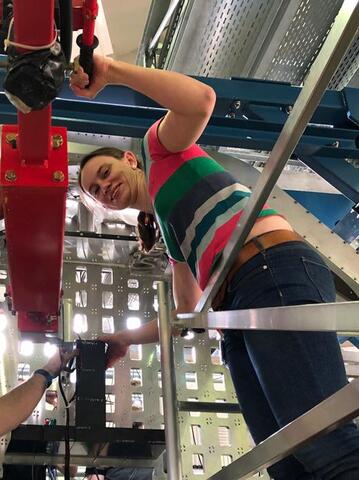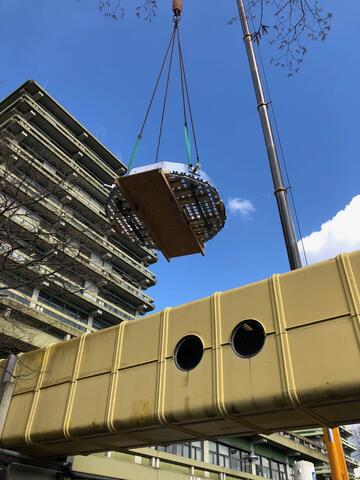Workshop „Physics Opportunities with Proton Beams at SIS100” was held in Wuppertal
PANDA meetings
04/03-08/03 2024 CM 24/1 in Münster
24/06-28/06 2024 CM 24/2 at GSI
25/06-26/06 2024 FEE/DAQ Workshop
04/11-06/11 2024 CM 24/3 at GSI
05/03-07/03 2025 WS at GSI
16/06-20/06 2025 CM 25 in Uppsala
Development and test of a prototype for the PANDA Barrel DIRC detector at FAIR
Grzegorz Kalicy
TH-PHD-2015-006.pdf
(35.68 MB)
The PANDA experiment at FAIR will perform world class physics studies using high-intensity
cooled antiproton beams with momenta between 1.5 and 15 GeV/c. A rich physics program
requires very good particle identification (PID). Charged hadron PID for the barrel section
of the target spectrometer has to cover the angular range of 22-140deg and separate pions from
kaons for momenta up to 3.5 GeV/c with a separation power of at least 3 standard deviations.
The system that will provide it has to be thin and operate in a strong magnetic field. A ring
imaging Cherenkov detector using the DIRC principle meets those requirements. The design
of the PANDA Barrel DIRC is based on the successful BABAR DIRC counter with several
important changes to improve the performance and optimize the costs. The design options are
being studied in detailed Monte Carlo simulation, and implemented in increasingly complex
system prototypes and tested in particle beams. Before building the full system prototypes
the radiator bars and lenses are measured on the test benches. The performance of the DIRC
prototype was quantified in terms of the single photon Cherenkov angle resolution and the
photon yield. Results for two full system prototypes will be presented. The prototype in 2011
aimed at investigating the full size expansion volume. It was found that the resolution for
this configuration is at the level of in good agreement with ray tracing simulation results. A
more complex prototype, tested in 2012, provided the first experience with a compact fused
silica prism expansion volume, a wide radiator plate, and several advanced lens options for
the focusing system. The performance of the baseline configuration of the prototype with
a standard lens and an air gap met the requirements for the PANDA PID for most of the
polar angle range but failed at polar angles around 90deg due to photon loss at the air gap.
Measurements with a prototype high-refractive index compound lens without an air gap at a
polar angle of 128deg beam angle showed a good resolution of signa(thetaC) = 11.8 +- 0.7 mrad and a high
photon yield of Nph = 26.1 +- 0.4. Even at polar angles close to 90deg the photon yield with
this lens exceeded 15 detected photons per particle, meeting the PANDA Barrel DIRC PID
requirements for the entire phase space and demonstrating that the compact focusing DIRC is
a very promising option for PANDA.
cooled antiproton beams with momenta between 1.5 and 15 GeV/c. A rich physics program
requires very good particle identification (PID). Charged hadron PID for the barrel section
of the target spectrometer has to cover the angular range of 22-140deg and separate pions from
kaons for momenta up to 3.5 GeV/c with a separation power of at least 3 standard deviations.
The system that will provide it has to be thin and operate in a strong magnetic field. A ring
imaging Cherenkov detector using the DIRC principle meets those requirements. The design
of the PANDA Barrel DIRC is based on the successful BABAR DIRC counter with several
important changes to improve the performance and optimize the costs. The design options are
being studied in detailed Monte Carlo simulation, and implemented in increasingly complex
system prototypes and tested in particle beams. Before building the full system prototypes
the radiator bars and lenses are measured on the test benches. The performance of the DIRC
prototype was quantified in terms of the single photon Cherenkov angle resolution and the
photon yield. Results for two full system prototypes will be presented. The prototype in 2011
aimed at investigating the full size expansion volume. It was found that the resolution for
this configuration is at the level of in good agreement with ray tracing simulation results. A
more complex prototype, tested in 2012, provided the first experience with a compact fused
silica prism expansion volume, a wide radiator plate, and several advanced lens options for
the focusing system. The performance of the baseline configuration of the prototype with
a standard lens and an air gap met the requirements for the PANDA PID for most of the
polar angle range but failed at polar angles around 90deg due to photon loss at the air gap.
Measurements with a prototype high-refractive index compound lens without an air gap at a
polar angle of 128deg beam angle showed a good resolution of signa(thetaC) = 11.8 +- 0.7 mrad and a high
photon yield of Nph = 26.1 +- 0.4. Even at polar angles close to 90deg the photon yield with
this lens exceeded 15 detected photons per particle, meeting the PANDA Barrel DIRC PID
requirements for the entire phase space and demonstrating that the compact focusing DIRC is
a very promising option for PANDA.





